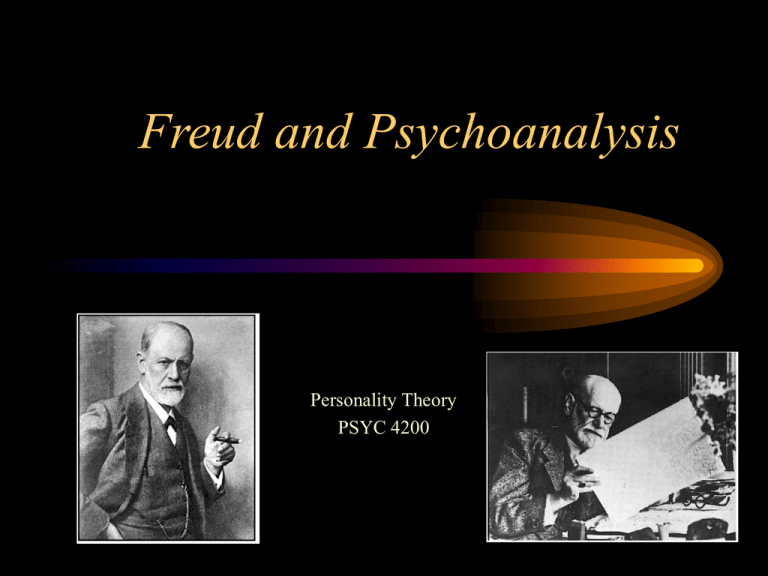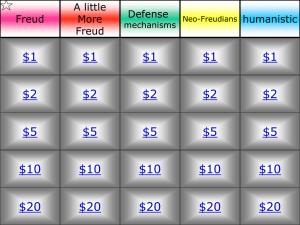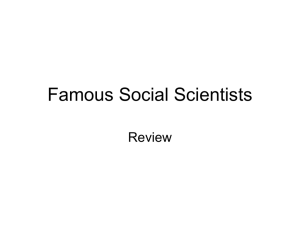Structural and Topographic Models of the Mind
advertisement

Freud and Psychoanalysis Personality Theory PSYC 4200 Why Use Psychoanalytic and Psychodynamic Models? • Advantages – historical continuity – clinical utility – some empirical validation • Disadvantages – – – – many aspects unprovable, unrefutable highly inferential, less inter-rater unreliability many tenets have been discredited hard to integrate with neurobiological model Models and Innovators • S. Freud - “classical” • A. Freud, Hartman, Kris, Lowenstein - ego psychology, object relations • Sullivan - interpersonal model • French, Alexander - psychosomatics • Winnicott, Klein - primitive (infantile) mind • Kohut - self-psychology Basic Postulates of Psychoanalysis Psychic life is determined The unconscious plays a dominant role in determining human behavior The most important explanatory concepts are motivational The history of the organism is of extreme importance in determining contemporary behavior Some Major Characteristics of Freud’s Thought Determinism Belief in the Continuity of the Animal Kingdom Role of Unconscious Influences Developmental Emphasis Emphasis on Motivation Applied Psychology Determinism Freud appears to have been a determinist, although it was never clearly stated in his writings. He was particularly interested in how unconscious motives affect rational processes. Belief in the Continuity of the Animal Kingdom Influenced by Darwin, Freud insisted that humans have no grounds for excluding themselves from the animal kingdom. He subscribed to the position that "no spirits, essences, or entelechies, no superior plans or ultimate purposes are at work. The physical energies alone cause effects-somehow." Role of Unconscious Influences Developmental Emphasis Psychoanalytic theory gives importance to development and growth. Abilities vary as a function of age and early events in life are consequential to later adjustment. Furthermore, there are identifiable developmental stages that must be negotiated to insure later psychological health and well-being. Emphasis on Motivation Psychoanalysis emphasizes he importance of motivation. Freud repeatedly referred to the centrality of pleasure in human life and to specific determinants of its expression. Applied Psychology A great deal of Freud's intellectual energy was devoted to the problems of effective intervention and treatment. The term psychoanalysis seems to refer simultaneously both to a system of psychology and to a treatment technique. Life’s Major Goal and Its Inevitable Frustration From the beginning of life we seek pleasure and avoid pain. Pleasure results from the satisfaction of needs, but we find that the world is not very cooperative. There are sources of suffering (our body, the world, other people) which we try to avoid using various methods (substituting one gratification for another, religion, love) Motivation and Unconscious Processes Orgel (1990) pointed out that "the core idea of psychoanalysis begins with the assumption that in every human being there is an unconscious mind." Freud’s early experiences with hypnosis had important effects on the development of this part of his theory. However, his larger vision of motivation was more complicated and multidimensional. Instinct The term is often used as the translation for Freud’s term Trieb, which is close in meaning to the term drive. According to Freud, Trieb is an internal stimulus that persists until it finds satisfaction. It has a somatic source, a strength, an aim (its own satisfaction), and an object (that which will help it achieve its aim). Life Instincts These instincts perpetuate (a) the life of the individual, by motivating him or her to seek food and water, and (b) the life of the species, by motivating him or her to have sex. The motivational energy of these life instincts, the "oomph" that powers our psyches, he called libido, from the Latin word for "I desire." Death Instinct Libido is a lively thing; the pleasure principle keeps us in perpetual motion. And yet the goal of all this motion is to be still, to be satisfied, to be at peace, to have no more needs. The goal of life, you might say, is death! Freud began to believe that "under" and "beside" the life instincts there was a death instinct. He began to believe that every person has an unconscious wish to die. Anxiety Freud believed that there are specific varieties of anxiety associated with some of the important and pervasive tensions that we all must face. Objective Anxiety Neurotic Anxiety Moral Anxiety Objective Anxiety Objective threats from the world or from other people that threaten to overpower the ego. Neurotic Anxiety According to Freud, this arises when the irrational demands of the id threaten to overwhelm the ego. Moral Anxiety According to Freud, anxiety associated with the threat that the irrational demands of the superego might overcome the ego. The Structure of Personality Id Ego Superego The Id In Freudian theory, the id is the most primitive component of the personality. It represents powerful biological needs and demands instant expression and immediate gratification. The Ego In Freud’s system, the ego is the "I" or me of the personality--the center of organization and integration that must adapt to the demands of reality. Jung used the term in a similar way as a component of personality that is closely associated with conscious process. The Superego According to Freud, that part of the personality consisting of internalized social norms, values, and ideals. It serves the goal of perfection and attempts to appropriate ego activities to serve its goal. Structural and Topographic Models of the Mind Developmental Stages • • • • • 0ral Anal Phallic - oedipal Latency Genital Oral In Freud’s psychology the first stage of psychosexual development. In this stage, the child’s interactions with the world are primarily via the oral cavity and there is primitive learning about the responsiveness of the world to oral activities such as crying and sucking. Anal According to Freud, in the second and third years of life, the child develops a deep awareness of the pleasures associated with relief of bowel and bladder tension. The expression of this pleasure may be in conflict with societal norms and thus create special difficulties that must be negotiated with care if the child is to develop normally. Phallic In Freud’s psychology, that period from 3 to 5 when the child develops an interest in his other sex organs and the sex organs of the parent. Freud believed that, at this time, the child begins to identify with the oppositesex parent. Latency According to Freud, the period between the phallic stage and the genital stage. In the latency period there is no obvious localization of erotic interest. Genital According to Freud, this stage is associated with the adolescent years and is marked by the development of emotional ties with member of the opposite sex. Defense Mechanisms • • • • • Everyone uses them to deal with distress Everyone has characteristic repertoire Hierarchy of mechanisms Rough correlation with pathology More “primitive” defenses seen in regression or certain disorders Defense Mechanisms of the Ego Repression Projection Regression Reaction Formation Other Defenses Repression An ego defense mechanism in which dangerous thoughts, memories, or perceptions are forced out of consciousness and into the unconscious realm. Projection A defense mechanism of the ego manifested when personal faults or weaknesses are externalized or ascribed to objects, events or other people. Thus, a marital partner tempted to be unfaithful may ascribe the wish to be unfaithful to his or her partner. Regression Return or retreat to an earlier stage of development and reinstatement of attitudes or behaviors that were characteristic of an earlier stage. Reaction Formation A paradoxical situation in which the instinct may undergo a reversal into its opposite (love to hate, pleasure to pain, passivity to activity, etc.). Ego masks awareness of an anxietyprovoking motive by emphasizing its opposite. Sublimation According to Freud, any of a variety of socially acceptable activities such as work, play, or philanthropic activities that represent a rechanneling of sexual energy along socially acceptable lines. In general, sublimation involves the substitution of a higher, more socially acceptable activity for an activity that is less socially acceptable. Rationalization A defense mechanism of the ego marked by the practice of employing false but logical or even plausible explanations designed to excuse weakness or errors. Rationalization Identification or Introjection In Freudian psychology, a defense mechanism of the ego marked by imitation of another person. The ego attempts to borrow from the success or adequacy of another individual. Identification Introjection Denial Blocking external events from awareness. If some situation is just too much to handle, the person just refuses to experience it. As you might imagine, this is a primitive and dangerous defense -- no one disregards reality and gets away with it for long! It can operate by itself or, more commonly, in combination with other, more subtle mechanisms that support it Denial Intellectualization Asceticism The renunciation of needs Displacement The redirection of an impulse onto a substitute target. If the impulse, the desire, is okay with you, but the person you direct that desire towards is too threatening, you can displace to someone or something that can serve as a symbolic substitute. Undoing ”Magical" gestures or rituals that are meant to cancel out unpleasant thoughts or feelings after they've already occurred. Anna Freud mentions, for example, a boy who would recite the alphabet backwards whenever he had a sexual thought. Psychoanalysis Dynamic Therapies • Psychoanalysis • Psychodynamic psychotherapy Psychoanalysis as a Therapeutic Technique Freud’s theory of treatment assumes the operation of specific functional arrangements between conscious and unconscious processes. The conscious mind has only indirect access to the dangerous materials that reside in the unconscious domain. Psychoanalysis as a Therapeutic Technique Freud found evidence for unconscious processes in hypnotic phenomena, slips of the tongue, forgotten appointments, and dreams. Dreams have manifest content and latent content. The former refers to the dream as described by the dreamer, the latter refers to the specific way the dream expresses an unconscious wish or drive. Psychoanalysis as a Therapeutic Technique Freud contended that a major goal of therapy is to return back to the ego "its mastery over lost provinces of...mental life." He believed that dreams provide the most important avenue for the expression of unconscious forces, but that there is therapeutic value in simply sharing one’s story and in free association. Elements of Dynamic Therapy • • • • • • Uncovering Regression Resistance Insight Transference Reconstruction Indications for Psychodynamic Therapy • Acute focal conflict (conversion, inhibition) • Major depression (IPT) • Personality disorders or chronic, problematic interpersonal patterns • Dissociative disorders • Trauma-related disorders • Resistance to BT, CBT Transference Countertransference Resistance Appreciative Overview Emphasis on development Unconscious processes Focus on motivation Psychotherapy Interdisciplinary contributions Critical Overview Tendency to over generalize Empirical verification Closedness Sexual emphasis Psychoanalytic treatment Theory of female sexuality



![Freud[1]](http://s3.studylib.net/store/data/009188810_1-b4da58acda3597f24583464fef8dd596-300x300.png)




